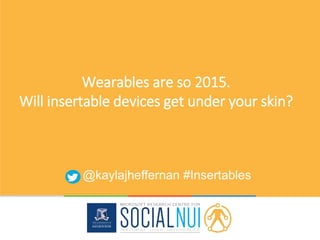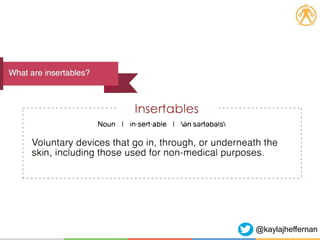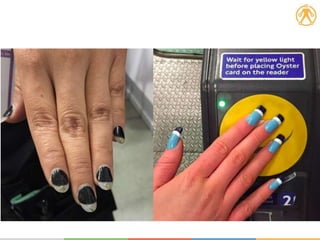Wearables are so 2015. Will insertable devices get under your skin?
- 1. Wearables are so 2015. Will insertable devices get under your skin? @kaylajheffernan #Insertables
- 2. Insertables
- 5. Implantable Medical Devices Luggable Wearable Insertable @kaylajheffernan
- 6. Luggable > Wearable > Implant / Insertable
- 12. MicroCHIPS RFID Contraceptive Device. MIT @kaylajheffernan
- 14. BabyPod Music via the vagina @kaylajheffernan
- 15. Kinsa Smart Thermometer IoT Rectal Thermometer @kaylajheffernan
- 16. So, what are people inserting? @kaylajheffernan
- 17. RFID & NFC Microchips About the size of a grain of rice @kaylajheffernan
- 18. @kaylajheffernan Where do they put them?
- 20. 3 tap check ŌĆó Phone ŌĆó Wallet ŌĆó Key
- 21. Have you ever ŌĆ” ŌĆó Forgotten your work pass? ŌĆó Forgotten your Myki? ŌĆó Forgotten your credit card? ŌĆó Locked your keys inside your car? ŌĆó Gotten locked out of your house?
- 25. ŌĆ£ I was super-duper thankful that I went through this small tiny piece of pain for the guarantee that my key would be with me as long as I have my hand, which IŌĆÖve never ever forgotten. It only takes one or two times of making a bullshit trip thatŌĆÖs already too long and having to drive the whole way back home, or deal with it for the day, to make you realize like oh a small pinch and this is solved? Yeah, please give me the pinch. ŌĆØ
- 27. ŌĆ£ It made everything easier, I didnŌĆÖt have to type things in or interact with the interfaces, I just had to run my hand over my phone and I was on my way. ŌĆØ
- 30. Questions ŌĆó Does it hurt? ŌĆó Can the government track me? ŌĆó Do you have one? ŌĆó Can you feel it? ŌĆó May YOU feel it? ŌĆó What if someone cuts off my hand?
Editor's Notes
- #2: Over the last century the body has emerged as a platform for devices, including internal medical devices and wearable fitness monitors. Within the last decade individuals have begun voluntarily inserting non-medical devices into their bodies. What are people putting in their bodies and why? Are insertables the next thing?
- #3: When people ask me what I do my PhD in, and I say ŌĆ£insertable devicesŌĆØ I generally get this reaction
- #4: We use the term insertables to refer to non-permanent voluntary devices contained within the boundaries of the body ŌĆō in through or underneath the skin. Insertables are characterized by agency and choice and are therefore used for non-medical purposes.
- #5: For example, piercings would count as an insertable object, and if you placed sensors on them they would count as insertable devices.
- #6: Implantable medical devices (IMDs), on the other hand are those inserted into the body for restorative purposes are generally not optional. Many of these devices started as luggables bought to the patient, becoming wearable with technological advancements and then fully insertable ŌĆō for example the pacemaker
- #7: We can see this trajectory in many health devices. Vision and hearing aids begin to blur the line of insertables as they are medical in nature, but optional.
- #10: We are now seeing insertable form of non-life threatening health and wellbeing products. For example contraceptives exists as wearable prophylactics or insertable in the form of female condoms, diaphragms, intrauterine devices (IUDs) and sub-dermal contraceptive implants.
- #11: Menstrual aids too have wearable or insertable forms, with an individual being able to choose whichever they are more comfortable with ŌĆō wearable pads or insertable tampons or menstrual cups. Even incontinence aids have wearable diapers and a new insertable counterparts for women.
- #12: Even incontinence aids have wearable diapers and a new insertable counterparts for women.
- #13: As individuals becomes more comfortable with insertables inside their bodies these are becoming insertable devices. MircoCHIPS RFID contraceptive currently in development with MIT
- #14: LoonCup, the IoT smart menstrual cup. Successfully kickstarted.
- #15: And BabyPod ŌĆō Insertable speakers to play music to your unborn feotes. These are real, available devices that have some market.
- #16: But itŌĆÖs not all vaginaŌĆÖs. ThereŌĆÖs an IoT smart rectal themometer.
- #17: So what are people inserting? RFID & NFC Microchips Magnets from sensorial extension & Bespoke devices. For the rest of the talk IŌĆÖm going to be concentrating on microchips
- #18: RFID & NFC microchips are approximately the size of a grain of rice. They are inserted using large gauge syringes like those used to body piercings of pet micro chipping. Once inserted they are invisible to the naked eye.
- #19: The insertion position selected is generally based on use, with form following function. The standard position for microchips is in the webbing of the The webbing is away from vital tissues and organs, provides protection for the chip and affords an easy and natural interaction with sensors and phones.
- #20: LetŌĆÖs talk about UX and Delight
- #21: Cut by a third
- #23: Getting locked out sucks. ItŌĆÖs incredibly stressful. ItŌĆÖs even worse when youŌĆÖve stepped outside for some reason and the door blows shut. The baby is inside. ThereŌĆÖs something on the stove. YouŌĆÖre only in a nightie or worse. What do you do? You wait around for a locksmith, you try to climb through the cat flap or open a window.
- #24: Having an NFC compatible lock means that the door slams behind you, and you have that initial panic and then remember this doesnŌĆÖt matter for you, you canŌĆÖt forget your keys theyŌĆÖre always with you.
- #25: So we see this luggable, wearable, insertable trajectory again. Replacing luggable keys and wearable dongles with insertables.
- #26: As one participant puts it: I was super-duper thankful that I went through this small tiny piece of pain for the guarantee that my key would be with me as long as I have my hand, which IŌĆÖve never ever forgotten. It only takes one or two times of making a bullshit trip thatŌĆÖs already too long and having to drive the whole way back home, or deal with it for the day, to make you realize like oh a small pinch and this is solved? Yeah, please give me the pinch.
- #27: The chips ŌĆ£can do anything, you just have to program it toŌĆØ. People using microchips to automate mundane takes such as launching Facebook and even Pokemon Go. Basically anything your phone can do can be programmed to do when you scan your chip. When I scan this text my wife IŌĆÖm on the way home, send an email, share my contact detail etc. Insertables offer a way to automatically and seamlessly launch applications without need to stop and interact with devices, other than to hold their hand to a reader, making them natural user interfaces (NUIs) with intuitive and seamless interactions.
- #28: For example, one participant set up the coordinates of his lab ┬Ā
- #29: Users of insertables no longer wanted to be bothered by wearables - they are frustrating They opt in to insertables. For them, the benefits out weighed any pain or discomfort. They didn'tŌĆÖt want to manage keys, wallets or purses and phones they could forget,, put wearables on and off and make sure theyŌĆÖre charged. Some found wearables uncomfortable and didnŌĆÖt even wear their wedding rings. Participants had eliminated keys, dongles and external devices by relegating these input and storage functions to insertable devices. You try and minimize the number of things they worry about in the day - one partricipant refered to this as the tamagotchi effect ┬Ā
- #30: It is true, however, that not all users will be satisfied with inserting devices into their bodies. Gluing RFID tags onto nails is ŌĆ£far less controversialŌĆØ and threatening for the wider populous. Wearable and insertable devices can coexist alongside one another with users being able to choose whichever they are comfortable with, and what meets their needs.
- #32: The bodyŌĆÖs roughly 2 square metres of skin is a canvas for devices. The insides of the body are no longer limited to just implantable medical devices as some individuals are already experimenting to use the internal 66L as a platform for insertable devices. As acceptance grows, insertables may become a device mode of choice for future NUIs.































